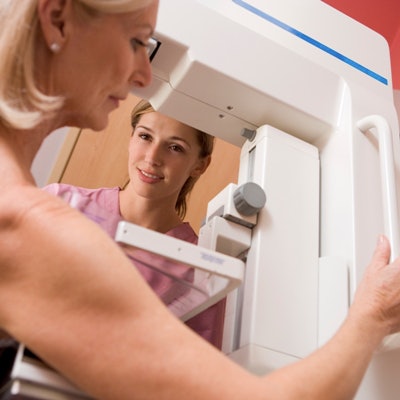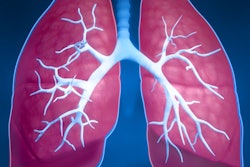
The problem of overdiagnosis in cancer screening has been hotly debated for years, with a variety of imaging exams on the list of services some say lead to the phenomenon. An article published June 26 in the Annals of Internal Medicine tries to clear up the confusion by defining overdiagnosis and the conditions that lead to it.
 Dr. Louise Davies from the Dartmouth Institute for Health Policy and Clinical Practice.
Dr. Louise Davies from the Dartmouth Institute for Health Policy and Clinical Practice.
Although overdiagnosis in cancer detection and screening has received increasing attention, its occurrence doesn't seem to deter patients from screening.
"[Current] data suggest that people remain highly interested in being screened despite recognizing that a detected cancer may be indolent," the group wrote. "Fear of cancer is responsible for some of these opinions; however, the problem is broader than that: Recent work to understand the U.S. public's view of low-value care -- a concept related to overdiagnosis -- showed that 'most of the health respondents had difficulty envisioning how healthcare, particularly testing, could be harmful.' "
Confusing concept
The concept of overdiagnosis is particularly hard to communicate to patients, not only because it's difficult to measure directly but also because it's often conflated with harms such as overtreatment, misclassification, false-positive results, and overdetection, according to the authors. In an attempt to clarify the confusion, Davies and colleagues sought to define the term, describe how variations of estimates of overdiagnosis occur, outline other ways to estimate overdiagnosis, and list best practices for communicating to patients the potential harm overdiagnosis can cause.
"We realized that the definitions of overdiagnosis are quite variable," Davies told AuntMinnie.com. "So we wanted to create a definition that would capture how most people define the term but also narrow it enough so that overdiagnosis rates can be calculated more easily."
In cancer-specific literature, overdiagnosis has been described as screen-detected cancers that would not have been identified during the patient's lifetime without screening. Some definitions add that the screen-detected cancer must be histologically confirmed or nonprogressive or would not have resulted in illness or death if it had not been found; other researchers frame the definition of overdiagnosis through the question of whether the person in which the cancer was identified receives benefit from screening.
Although this last definition in particular may be conceptually correct, it's not necessarily measurable unless the patient is harmed, Davies and colleagues wrote. So they recommend the following definition: Overdiagnosis is "the detection of a (histologically confirmed) cancer through screening that would not otherwise have been diagnosed in a person's lifetime had screening not been done."
Exact estimates
Estimates of overdiagnosis rates vary widely and are affected by factors such as disease prevalence in a patient population and health risks from other causes, according to the authors. Because the frequency of overdiagnosis is usually presented as a proportion, the group recommended the following formula to estimate it:
- The numerator should be the number of screen-detected cases of cancer, histologically confirmed, that would not otherwise have been detected before the person's death from other causes.
- The denominator should be the number of persons who were screened (for patients) or persons invited to screening (for program evaluation).
"Recent studies suggest that patients may most easily understand the number of overdiagnosed cancer cases per total number of persons screened, whereas policy planners may prefer to use the number of persons invited to be screened," the authors wrote.
Better communication?
Barriers that can prevent patients from understanding the concept of overdiagnosis are legion and include the following, according to Davies' group:
- Historical positive messaging about the value of early detection in cancer
- Societal and personal fears about cancer
- Financial incentives created by fee-for-service healthcare systems
- The normal human intolerance for uncertainty
- Biases toward action in healthcare
- The "moral hazard" created by health insurance
- Pressures from the medical device industry, pharmaceutical companies, and physician specialties.
The authors noted that in the example of breast cancer screening, women need to be told that screening is a choice and overdiagnosis a potential harm, but they also acknowledged that educating patients about overdiagnosis is tricky: Focusing on cost or waste as a reason to avoid screening can backfire if patients believe the savings will go to the facility rather than to themselves. Meanwhile, encouraging patients to question doctors' screening recommendations can erode trust -- which could interfere with their participating in screening they need.
To better communicate the concept of overdiagnosis to patients and to encourage decisions that are congruent with patients' stated values, priorities, and risk tolerances, the group recommended that physicians "consider the target audience, keep the messaging simple ... be attentive to the wording of potential outcomes ... and present both ... benefits and harms from screening."
Radiologists' role
Imaging tests figure prominently on the list of examples of services that Davies and colleagues said can lead to "too much medicine" in cancer screening.
| Imaging exams related to 'too much medicine' in cancer screening | |
| Term | Imaging example |
| Overdiagnosis | Ductal carcinoma in situ (DCIS) found after screening mammography and biopsy |
| Small papillary thyroid cancer identified on ultrasound and fine-needle aspiration | |
| False positive | Positive mammography result leading to a biopsy not diagnostic for breast cancer |
| Identification of lung nodule on CT leading to a biopsy not diagnostic for lung cancer | |
| Incidental findings of uncertain significance | Thyroid nodule found on low-dose CT for lung cancer screening |
| Adrenal mass found on CT colonography for colorectal cancer screening | |
| Overtreatment | Lumpectomy or mastectomy for DCIS |
| Prostatectomy of low-grade prostate cancer | |
| Thyroidectomy for smaller than 1 cm papillary thyroid cancer | |
| Overutilization | Frequent surveillance for BI-RADS grade 2 or 3 mammography findings |
| Frequent ultrasound or biopsy of thyroid nodules | |
| Surveillance CT colonography or colonoscopy for adenomas | |
| Frequent lung CT for monitoring lung nodules | |
Yet despite imaging's vulnerability to the problem of overdiagnosis, radiologists need to understand that they hold a unique position in the healthcare continuum and, therefore, are an important part of the dialogue about the issue, Davies said.
"What radiologists say and how they say it drives a lot of healthcare decisions," she said. "Words that are or are not present in a radiology report have a real impact on the end user of that report. It's crucial that radiologists be informed about the concept of overdiagnosis."



















